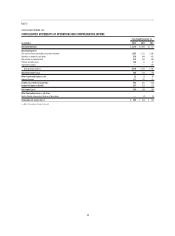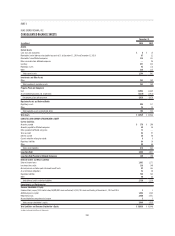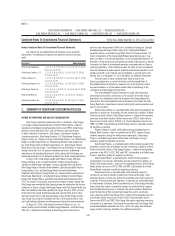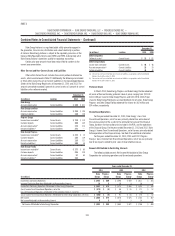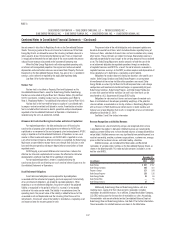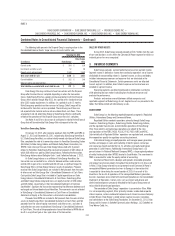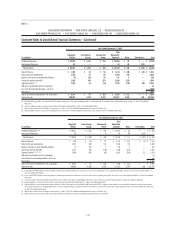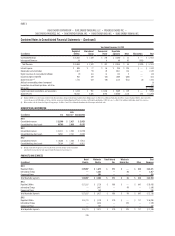Duke Energy 2014 Annual Report Download - page 128
Download and view the complete annual report
Please find page 128 of the 2014 Duke Energy annual report below. You can navigate through the pages in the report by either clicking on the pages listed below, or by using the keyword search tool below to find specific information within the annual report.
108
PART II
DUKE ENERGY CORPORATION • DUKE ENERGY CAROLINAS, LLC • PROGRESS ENERGY, INC. •
DUKE ENERGY PROGRESS, INC. • DUKE ENERGY FLORIDA, INC. • DUKE ENERGY OHIO, INC. • DUKE ENERGY INDIANA, INC.
Combined Notes to Consolidated Financial Statements – (Continued)
December 31,
(in millions) 2014 2013
Duke Energy Ohio 79 89
Duke Energy Indiana 112 144
Allowance for Doubtful Accounts
Allowances for doubtful accounts are presented in the following table.
December 31,
(in millions) 2014 2013 2012
Allowance for Doubtful Accounts
Duke Energy $17 30 34
Duke Energy Carolinas 333
Progress Energy 814 16
Duke Energy Progress 710 9
Duke Energy Florida 247
Duke Energy Ohio 222
Duke Energy Indiana 111
Allowance for Doubtful Accounts – VIEs
Duke Energy $51 43 44
Duke Energy Carolinas 666
Progress Energy 8——
Duke Energy Progress 5——
Duke Energy Florida 3 ——
Derivatives and Hedging
Derivative and non-derivative instruments may be used in connection
with commodity price, interest rate and foreign currency risk management
activities, including swaps, futures, forwards and options. All derivative
instruments except those that qualify for the normal purchase/normal sale
(NPNS) exception are recorded on the Consolidated Balance Sheets at their
fair value. Qualifying derivative instruments may be designated as either cash
fl ow hedges or fair value hedges. Other derivative instruments (undesignated
contracts) either have not been designated or do not qualify as hedges. The
effective portion of the change in the fair value of cash fl ow hedges is recorded
in AOCI. The effective portion of the change in the fair value of a fair value hedge
is offset in net income by changes in the hedged item. For activity subject to
regulatory accounting, gains and losses on derivative contracts are refl ected as
regulatory assets or liabilities and not as other comprehensive income or current
period income. As a result, changes in fair value of these derivatives have no
immediate earnings impact.
Formal documentation, including transaction type and risk management
strategy, is maintained for all contracts accounted for as a hedge. At inception
and at least every three months thereafter, the hedge contract is assessed to
see if it is highly effective in offsetting changes in cash fl ows or fair values of
hedged items.
See Note 14 for further information.
Captive Insurance Reserves
Duke Energy has captive insurance subsidiaries that provide coverage,
on an indemnity basis, to the Subsidiary Registrants as well as certain third
parties, on a limited basis, for various business risks and losses, such as
property, workers’ compensation and general liability. Liabilities include
provisions for estimated losses incurred but not yet reported (IBNR), as well as
estimated provisions for known claims. IBNR reserve estimates are primarily
based upon historical loss experience, industry data and other actuarial
assumptions. Reserve estimates are adjusted in future periods as actual losses
differ from experience.
Duke Energy, through its captive insurance entities, also has reinsurance
coverage with third parties for certain losses above a per occurrence and/or
aggregate retention. Receivables for reinsurance coverage are recognized when
realization is deemed probable.
Unamortized Debt Premium, Discount and Expense
Premiums, discounts and expenses incurred with the issuance of
outstanding long-term debt are amortized over the term of the debt issue. Call
premiums and unamortized expenses associated with refi nancing higher-cost
debt obligations in the regulated operations are amortized. Amortization expense
is recorded as Interest Expense in the Consolidated Statements of Operations
and is refl ected as Depreciation, amortization and accretion within Net cash
provided by operating activities on the Consolidated Statements of Cash Flows.
Loss Contingencies and Environmental Liabilities
Contingent losses are recorded when it is probable a loss has occurred
and can be reasonably estimated. When a range of the probable loss exists and
no amount within the range is a better estimate than any other amount, the
minimum amount in the range is recorded. Unless otherwise required by GAAP,
legal fees are expensed as incurred.
Environmental liabilities are recorded on an undiscounted basis when
environmental remediation or other liabilities becomes probable and can be
reasonably estimated. Environmental expenditures related to past operations
that do not generate current or future revenues are expensed. Environmental
expenditures related to operations that generate current or future revenues are
expensed or capitalized, as appropriate. Certain environmental expenditures
receive regulatory accounting treatment and are recorded as regulatory assets.
See Notes 4 and 5 for further information.
Pension and Other Post-Retirement Benefi t Plans
Duke Energy maintains qualifi ed, non-qualifi ed and other post-retirement
benefi t plans. Eligible employees of the Subsidiary Registrants participate in
the respective qualifi ed, non-qualifi ed and other post-retirement benefi t plans
and the Subsidiary Registrants are allocated their proportionate share of benefi t
costs. See Note 21 for further information, including signifi cant accounting
policies associated with these plans.
Severance and Special Termination Benefi ts
Duke Energy has an ongoing severance plan under which, in general,
the longer a terminated employee worked prior to termination the greater the
amount of severance benefi ts. A liability for involuntary severance is recorded
once an involuntary severance plan is committed to by management, or sooner,
if involuntary severances are probable and can be reasonably estimated. For
involuntary severance benefi ts incremental to its ongoing severance plan
benefi ts, the fair value of the obligation is expensed at the communication date
if there are no future service requirements, or over the required future service
period. From time to time, Duke Energy offers special termination benefi ts
under voluntary severance programs. Special termination benefi ts are recorded
immediately upon employee acceptance absent a signifi cant retention period.
Otherwise, the cost is recorded over the remaining service period. Employee



